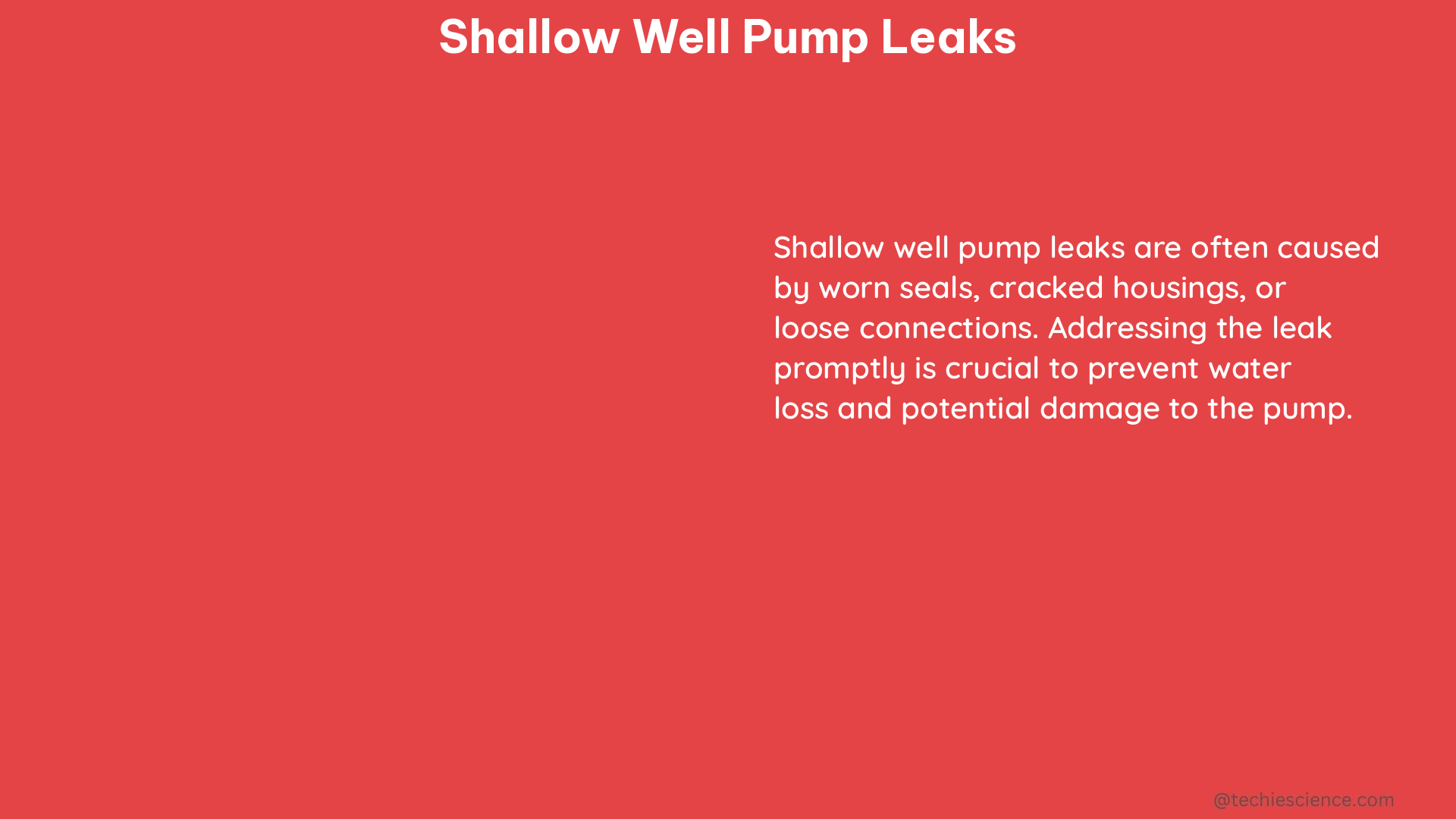Shallow well pump leaks can result in significant water loss, decreased pump efficiency, and increased operational costs. To address this issue effectively, it is crucial to understand the underlying causes, identify the source of the leak, and implement the appropriate repair strategies. This comprehensive guide will provide you with the necessary technical details and quantifiable data points to diagnose and resolve shallow well pump leaks.
Measuring Water Loss and Pump Efficiency
-
Water Loss: A leak in a shallow well pump can lead to water loss ranging from as little as 5 gallons per day to as much as 500 gallons per day, depending on the size and location of the leak. To quantify the water loss, you can use a water meter or a simple bucket test to measure the flow rate at the pump’s discharge.
-
Pump Efficiency: A leaking shallow well pump can reduce pump efficiency by up to 50%, leading to increased energy consumption and higher operational costs. You can measure the pump’s efficiency by calculating the ratio of the water output (in gallons per minute) to the power input (in watts or horsepower).
Pump Efficiency = (Water Output / Power Input) x 100%
For example, a shallow well pump with a water output of 10 gallons per minute and a power input of 1 horsepower (746 watts) would have an efficiency of approximately 45%.
Understanding Well Depth and Suction Lift

-
Well Depth: The depth of a shallow well can range from as little as 10 feet to as much as 50 feet, with the suction piping typically being 1 to 2 inches in diameter. The well depth and pipe diameter are crucial factors in determining the pump’s performance and the potential for leaks.
-
Suction Lift: The suction lift of a shallow well pump should not exceed 25 feet, as the pump may lose prime and fail to function properly. To measure the suction lift, you can use a water level meter or a simple dipstick to determine the distance between the water level and the pump’s intake.
Checking Check Valve Function and Threaded Joints
-
Check Valve Function: A properly functioning check valve should prevent water from flowing back into the well, maintaining prime and ensuring continuous pump operation. You can test the check valve by observing the water flow direction and checking for any backflow.
-
Threaded Joints: Shallow well pumps typically have several threaded joints, such as the connection between the pump and the suction pipe, that can leak if not properly sealed. These joints should be checked for leaks and sealed with thread paste, PTFE tape, or silicone tape to ensure a tight and secure connection.
Importance of Well Log and Registration
- Well Log and Registration: It is essential to have a well log and registration details to ensure proper maintenance and repair of the well and pump. The well log should include information about the well’s depth, diameter, construction materials, and any previous repairs or modifications. The registration details can help you identify the pump model and specifications, which are crucial for sourcing the correct replacement parts.
Diagnosing and Repairing Shallow Well Pump Leaks
To diagnose and repair a shallow well pump leak, follow these steps:
-
Measure Water Loss and Pump Efficiency: Use the techniques described earlier to quantify the water loss and pump efficiency. This will help you determine the severity of the leak and its impact on the system’s performance.
-
Inspect the Well Depth and Suction Lift: Measure the well depth and suction lift to ensure they are within the recommended ranges for your shallow well pump.
-
Check the Check Valve: Inspect the check valve for proper function and any signs of wear or damage. Replace the check valve if necessary.
-
Examine Threaded Joints: Carefully inspect all threaded joints in the pump and suction piping for leaks. Seal any leaks with thread paste, PTFE tape, or silicone tape.
-
Review Well Log and Registration: Consult the well log and registration details to ensure you have the correct pump model and replacement parts.
-
Perform Necessary Repairs: Based on your findings, perform the necessary repairs, such as replacing worn seals, gaskets, or the entire pump if the damage is extensive.
-
Test and Monitor: After completing the repairs, test the pump’s performance and monitor the system for any further leaks or issues.
By following this comprehensive guide and utilizing the provided technical details and quantifiable data points, you can effectively diagnose and repair shallow well pump leaks, ensuring optimal water conservation, pump efficiency, and cost-effective operation.
References:
- Shallow Jet Pump Always Loses Prime – Leak in Suction Piping – How to Find
- Shallow Well Pump Leaking
- Terry Love Plumbing Advice

The lambdageeks.com Core SME Team is a group of experienced subject matter experts from diverse scientific and technical fields including Physics, Chemistry, Technology,Electronics & Electrical Engineering, Automotive, Mechanical Engineering. Our team collaborates to create high-quality, well-researched articles on a wide range of science and technology topics for the lambdageeks.com website.
All Our Senior SME are having more than 7 Years of experience in the respective fields . They are either Working Industry Professionals or assocaited With different Universities. Refer Our Authors Page to get to know About our Core SMEs.